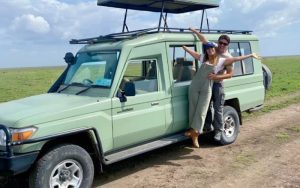For many travelers planning an African safari, one big question always comes up: How safe is gorilla trekking in Rwanda? The idea of walking into a rainforest to meet wild mountain gorillas can feel exciting, magical, and slightly intimidating. However, Rwanda is one of the safest and best-managed gorilla tourism destinations in the world. With strict park rules, professional rangers, highly trained trackers, and responsible conservation policies, gorilla trekking in Rwanda is a secure and well-organized activity suitable for all ages—including families, seniors, and first-time travelers to Africa.
In this detailed guide, we explain how safe is gorilla trekking in Rwanda, what protects visitors, how gorillas behave, what safety rules to follow, and why Rwanda remains a global leader in wildlife tourism and conservation.
How Safe Is Gorilla Trekking in Rwanda for Travelers?
Before asking how safe is gorilla trekking in Rwanda, travelers often wonder if the country itself is safe. Rwanda is one of Africa’s cleanest, most organized, and most peaceful nations. Kigali, the capital city, consistently ranks as one of the safest cities in Africa for tourists. Crime rates are extremely low, major roads are paved, and tourism infrastructure is well established.
-
Rwanda has a professional tourism police force
-
Roads to Volcanoes National Park are well maintained
-
English-speaking guides and rangers are always available
-
Medical facilities are accessible in major towns
-
Tourists are welcomed warmly and respectfully
Rwanda’s reputation for safety is one reason thousands of tourists travel for gorilla trekking every year.
How Safe Is Gorilla Trekking in Rwanda?
The answer: very safe. Gorilla trekking in Rwanda is carefully controlled and supervised. Every trek is guided by armed park rangers, professional trackers, and strict conservation rules. The gorillas you visit are habituated, meaning they are used to humans and show no aggression when rules are followed.
1. Gorilla Families Are Habituated
A key part of understanding how safe is gorilla trekking in Rwanda is knowing how gorillas interact with humans. In Volcanoes National Park, every visited gorilla family has gone through habituation, a long process where park experts gradually introduce the animals to human presence over several years.
Because of this:
-
Gorillas are calm and peaceful when people visit
-
Silverbacks (dominant males) rarely show aggressive behavior
-
Gorillas continue normal activities—feeding, playing, grooming, resting
Habituation is the first reason why gorilla trekking is safe.
2. Professional Rangers and Trackers, How Safe Is Gorilla Trekking in Rwanda
Every trekking group is escorted by:
-
Trained guides
-
Experienced trackers
-
Park rangers
Trackers locate the gorilla families early in the morning and remain with them until tourists arrive. Rangers understand gorilla body language, behavior, and forest movements. If a gorilla comes too close, rangers calmly instruct visitors on what to do.
This expert supervision ensures safety at all times.
3. Strict Safety Rules Protect Visitors, How Safe Is Gorilla Trekking in Rwanda
When tourists ask how safe is gorilla trekking in Rwanda, the answer includes clear tourist safety rules. Before entering the forest, visitors attend a briefing at Kinigi Headquarters. Rangers explain exactly how to behave near gorillas.
Key guidelines include:
-
Maintain a 10-meter distance from gorillas
-
Do not make sudden movements
-
Speak in a low voice
-
Do not touch the gorillas
-
Avoid direct eye contact with silverbacks
-
Follow the rangers’ instructions at all times
These rules keep both visitors and gorillas comfortable and safe.
4. Only Healthy Visitors Can Trek
To protect the animals and ensure safe interactions, visitors with infectious diseases like flu or COVID-19 may not trek. This reduces health risks for gorillas and keeps the trekking environment secure.
5. Small Group Sizes
Only 8 tourists are allowed to visit a gorilla family per day. This small group size:
-
Reduces noise
-
Keeps interactions controlled
-
Helps rangers manage safety more easily
How Dangerous Are Gorillas? How Safe Is Gorilla Trekking in Rwanda
Many travelers imagine gorillas as strong and aggressive because of their size. In reality, gorillas are gentle giants. They are vegetarian, shy, peaceful, and avoid conflict unless threatened.
Gorillas do not attack humans unless provoked. During habituated encounters, they continue daily routines—feeding, napping, playing, and caring for babies. If a silverback makes a loud sound or chest beats, it is usually a display to show dominance, not aggression. Rangers instruct visitors to remain still, look down, and stay calm.
How Safe Is Gorilla Trekking in Rwanda for Solo Travelers?
Solo travelers are very welcome. Once you join a group at the briefing center, you walk with guides, tourists, rangers, and trackers. You will never be alone in the forest. Many solo travelers describe gorilla trekking as safer than adventure activities like bungee jumping, white-water rafting, or mountain climbing.
How Safe Is Gorilla Trekking in Rwanda for Seniors or Children?
Families and older travelers often ask how safe is gorilla trekking in Rwanda when hiking difficulty is a concern. Rangers assign easier treks to visitors who request them. There are gorilla families located in low-altitude forests with short walking distances.
-
Porters carry bags
-
Walking sticks are provided
-
Some lodges offer massage or spa after trekking
-
Carriers or stretchers are available for travelers with mobility needs
Many seniors in their 60s, 70s, and even 80s successfully complete gorilla trekking every year.
How Safe Is the Forest Environment?
Volcanoes National Park is carefully protected. The trekking routes are safe, and wildlife does not attack hikers. The forest is home to golden monkeys, buffalo, birds, and rare primates—but rangers and trackers keep visitors safe. No tourist has ever been harmed by wildlife during a guided gorilla trek in Rwanda.
Safety Tips for Gorilla Trekking
To increase comfort and confidence, follow these simple tips:
-
Wear hiking boots with good grip
-
Carry a rain jacket or poncho
-
Bring gloves for holding vegetation
-
Hire a porter for support
-
Drink water and move slowly
-
Listen carefully to your guide
When rules are followed, gorilla trekking is very safe and enjoyable.
Rwanda’s Conservation Success Makes Trekking Safer
Part of understanding how safe is gorilla trekking in Rwanda comes from knowing its conservation success. Rwanda’s gorilla population has grown to more than 1,000 mountain gorillas, making it the only great ape population in the world that is increasing.
Why this matters for safety:
-
More habituated gorilla families
-
Stable, peaceful gorilla groups
-
Experienced conservation teams
-
Better forest protection and monitoring
Rwanda’s strong conservation policies make it a model for Africa and the world.
Tourist Safety Infrastructure
Volcanoes National Park offers:
-
Clean security checkpoints
-
Registered safari vehicles
-
Professional tour companies
-
Emergency radios for communication
-
First-aid trained rangers
-
Medical support available in nearby towns
Visitors are never left unprotected.
Community Support and Tourism Peace
Gorilla tourism supports local communities through jobs, park revenue sharing, and conservation projects. Because communities directly benefit, they protect the gorillas and welcome tourists. This positive relationship increases security around the national park.
How Safe Is Gorilla Trekking in Rwanda at Night or in Lodges?
Tourists stay in secure lodges with 24-hour staff. Rwanda has no dangerous predators roaming tourism areas, and lodges are built with strong safety systems.
Conclusion
So, how safe is gorilla trekking in Rwanda?
It is one of the safest wildlife activities on the continent. With professional rangers, habituated gorilla families, strict safety rules, clean tourism infrastructure, and a peaceful national environment, Rwanda provides a secure, well-managed, and unforgettable gorilla trekking experience.
Families, solo travelers, seniors, and first-time safari guests can trek with full confidence. Rwanda remains the world’s top destination for mountain gorilla encounters—and safety is one of the biggest reasons why.




